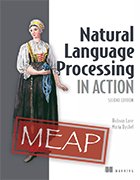Build a natural language processing chatbot from scratch
In this excerpt from the book 'Natural Language Processing in Action,' you'll walk through the steps of creating a simple chatbot to understand how to start building NLP pipelines.
To stay ahead in the AI race and eliminate growing concerns about its potential for harm, organizations and developers must understand how to use available tools and technologies to their advantage.
"Natural Language Processing may be the fastest-developing and most important field of Artificial Intelligence and Data Science," Hobson Lane and Maria Dyshel wrote in the second edition of Natural Language Processing in Action from Manning Publications Co. "If you want to change the world you will need to understand how machines read and process natural language text."
Natural language processing (NLP) is a technique used in AI algorithms that enables machines to interpret and generate human language. NLP improves interactions between computers and humans, making it a vital component of providing a better user experience.
By selecting -- or building -- the right NLP engine to include in a chatbot, AI developers can help customers get answers to recurring questions or solve problems. Chatbots' abilities range from automatic responses to customer requests to voice assistants that can provide answers to simple questions. While NLP models can be beneficial to users, they require massive amounts of data to produce the desired output and can be daunting to build without guidance.
This PDF excerpt from Chapter 1 of Lane and Dyshel's book, "Machines that Read and Write," outlines the steps to create a basic pattern-matching chatbot programmed to say, "Good morning, Rosa." The chapter also dives into pattern-based intent recognition with regular expressions, the importance of word order and grammar in NLP, and the stages of an NLP pipeline, which include parsing, analyzing, generating and executing.
Check out the rest of Natural Language Processing in Action to learn more about creating production-ready NLP pipelines as well as how to understand and generate natural language text. In addition, read co-author Lane's interview with TechTarget Editorial, where he discusses the skills necessary to start building NLP pipelines, the positive role NLP can play in the future of AI and more.







